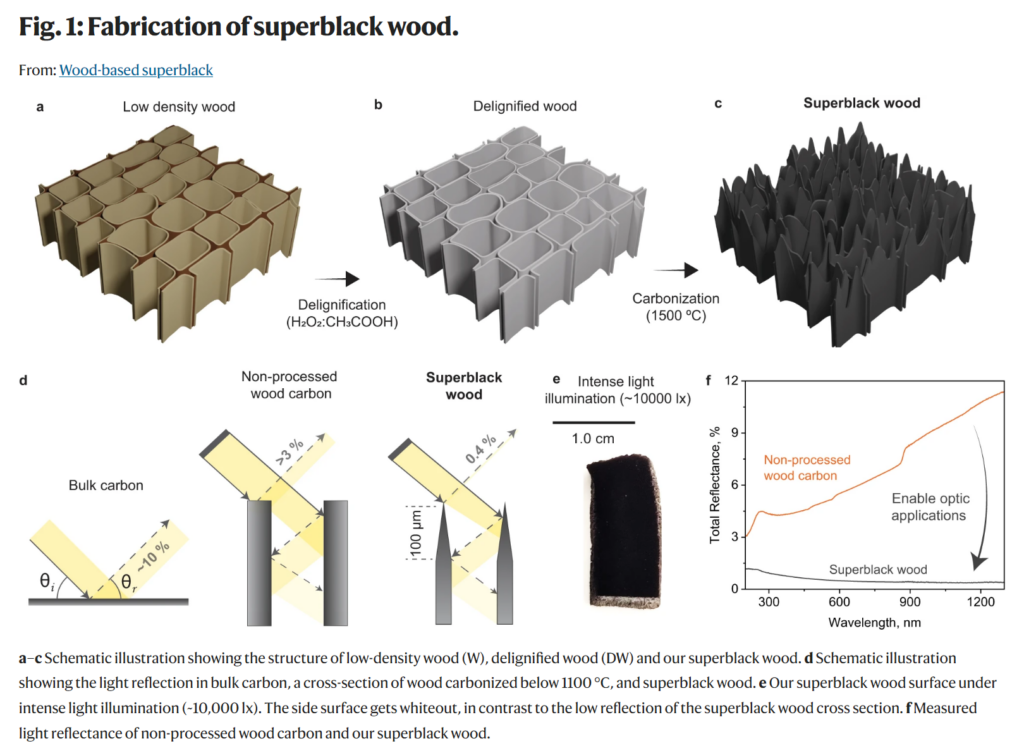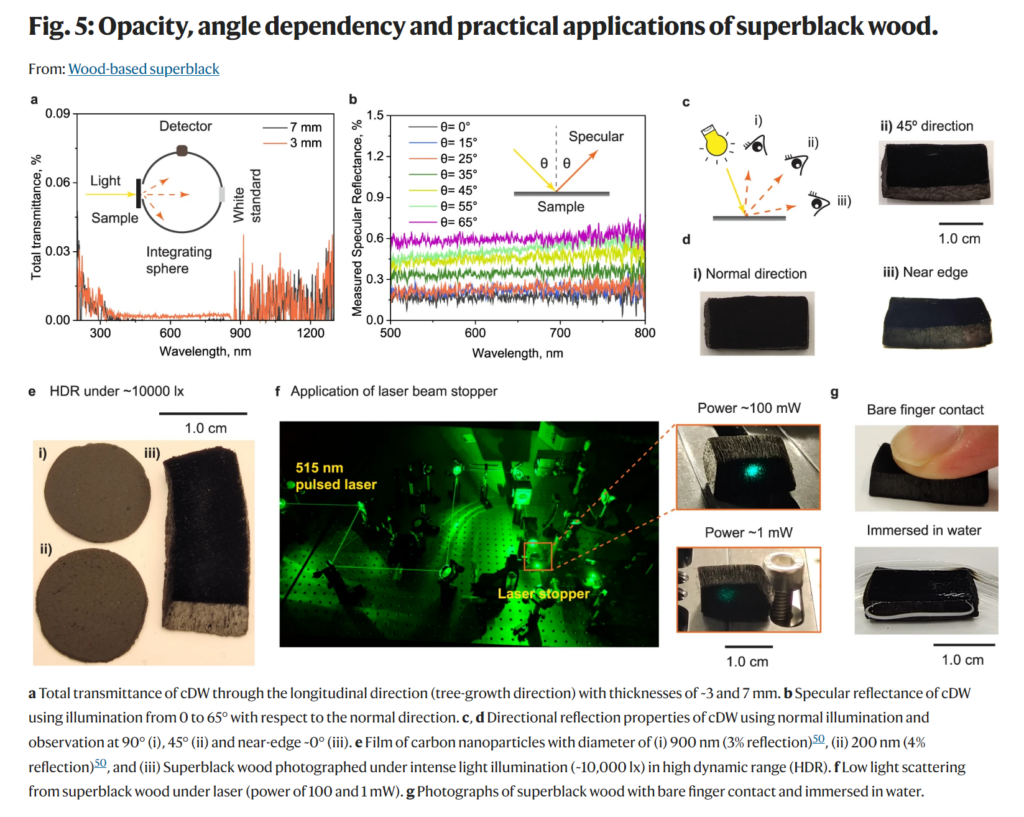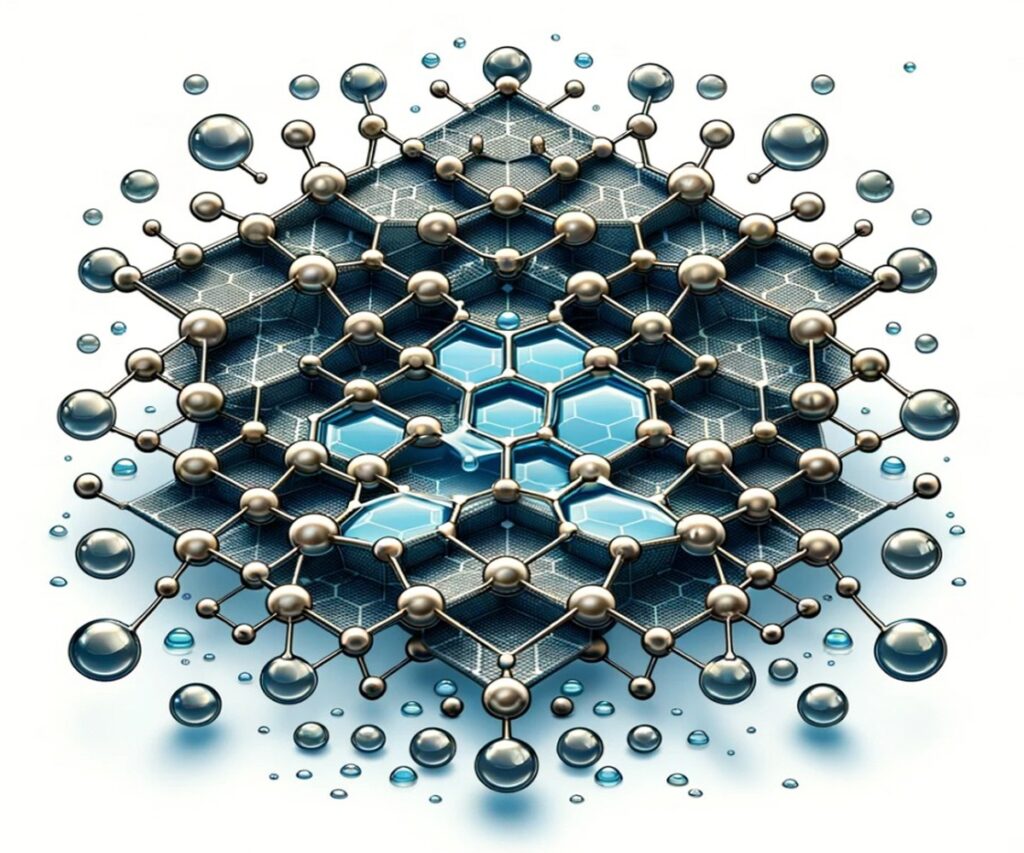Introduction: super black materials using wood
Materials with ultra-low light reflectance, known as super black materials, are in high demand for advanced solar harvesting and management, including black body coatings and solar energy harvesters and detectors. Super black material is used as a coating on various optical devices, including telescopes, to suppress unwanted scattering of light. These materials absorb over 99% of visible and infrared light, making them incredibly efficient at capturing photons for energy conversion or minimizing stray light interference.
The development of super black materials has been driven by the need for highly sensitive imaging and detection systems, particularly in astronomical and military applications. By reducing unwanted reflections, these coatings improve the signal-to-noise ratio, enhancing the clarity and accuracy of observations and measurements. Additionally, their exceptional light absorption properties make them valuable for thermal management in spacecraft and satellite systems, where controlling heat transfer is crucial for optimal performance.
One of the most well-known super black materials is Vantablack, a vertically aligned nanotube array that effectively traps and absorbs light within its intricate structure. This material has been used in various applications, including the coating of telescopes and scientific instruments, as well as in artistic installations and consumer products. However, researchers continue to explore alternative materials and production methods to improve performance, durability, and cost-effectiveness.
A recently published study suggests a new way to develop super black materials using wood. This material has a very low light reflectance and is attracting attention as an essential element in advanced solar harvesting and management technologies.

The cellular structure of wood consists of vertically aligned hollow tubes. This structure induces a mechanism to capture light. When light passes through the cell walls of wood, it is reflected by the hollow tube and passes through the cell walls again. As this process is repeated, light is gradually absorbed. The research team from Finland, Canada and China used hydrogen peroxide and acetic acid to delignify the wood and freeze-drying to obtain a stable structure. Delignification is a process that removes lignin, the brown pigment in wood, and increases the transparency of wood.
The delignified wood was subjected to a carbonization process at a temperature of 250 degrees in a nitrogen atmosphere. The cell walls of wood are composed of various substances such as cellulose, lignin, and hemicellulose. During the carbonization process, these substances are broken down and transformed into new substances.
Cellulose crystallizes during the carbonization process, forming a harder and more dense structure. Lignin is caramelized during the carbonization process and transformed into a brownish solid. Hemicellulose decomposes during the carbonization process and escapes as gas or vapor. The carbonization process allows wood to enhance internal light reflection and reduce back-scattered light.
As a result, a super black material was developed by applying the delignification and carbonization process to wood, and it was confirmed that the light reflectance was less than 0.4%.

Conclusion
This study presents a new approach to sustainability and reducing carbon footprint in the development of wood-based super black materials. This offers promising prospects compared to current solar harvesting and management technologies based on superblack materials based on metals or synthetic precursors. And super black material is not only used as a coating to suppress light scattering in optical devices, but can also be used for a variety of purposes, including regulating body temperature and enhancing striking features.
This study provides new insight into how the development of wood-based super black materials could impact solar harvesting and management technologies. It also provides important information about the sustainability and environmental benefits of these materials, and is expected to serve as inspiration for other fields of materials science.
Beyond their current applications, super black materials hold significant potential for advancing renewable energy technologies. Their ability to capture a wide range of the solar spectrum could lead to more efficient solar cells and thermal energy harvesters. Additionally, these materials could play a role in developing advanced camouflage systems, stealth coatings, and radiative cooling solutions for buildings and electronics.
Source: Zhao, Bin, et al. “Wood-based superblack” Nature communications 14.1 (2023): 7875
https://doi.org/10.1038/s41467-023-43594-4
※ This report is prepared for general information purposes based on data collected by CHEMiFORGE. If you have any questions or need to make a decision regarding the report, please consult with CHEMiFORGE.


